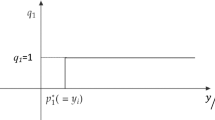Abstract
One of the earliest and most famous of the models that produce chaotic behaviour is the Logistic equation. It has a long history of use in economics and organization science studies. In those studies, the applicability of the equation is generally assumed rather than derived from first principles, with only conjecture offered as to the identity of the parameters.
This paper shows a deductive derivation of a Logistic equation for organizations in a competitive economy. The construct is based on a system that consists of one or more organizations, each with its own cost, productivity, and reinvestment parameters, and each having its individual population of employees.
The model is chaotic, and demonstrates some fascinating characteristics when organizations with parameters that individually would generate chaotic behaviour are mixed with organizations with parameters that individually would generate complex or stable behaviour. Some such mixed systems tend to initially behave like a complex or chaotic system, but transition over time to match the behaviour of the organization with the most “stable” parameters.
If a system is at equilibrium, changing one organization’s parameters can result in a burst of oscillations or chaotic activity while the system transitions to a new equilibrium. However, this activity can be delayed or might not occur at all.
Adding a number of real world complications to the Organization Logistic equation created a deterministic time-step simulation of an economic system. This simulation was also found to exhibit chaotic behaviour, nonmonotonicity, and the Butterfly Effect, as well as spontaneous bankruptcies.
The possibility that a competitive economic system might be inherently chaotic deserves further investigation. A broader insight is that the Scientific Method is not an appropriate scientific paradigm under which to grow social science knowledge if those social science systems are governed by chaotic mechanisms.
Similar content being viewed by others
References
Aoki, M. (1998), New Approaches to Macroeconomic Modeling: Evolutionary Stochastic Dynamics, Multiple Equilibria, and Externalities as Field Effects. Cambridge University Press, Cambridge.
Aoki, M. and H. Yoshikawa, (1999), Demand Creation and Economic Growth. Center for Research on the Japanese Economy, University of Tokio.
Ariyama, H. (1993), “Growth of Swimmong Crabs Portunus (Portunus) Tritubercalatus in Osaka Bay,” Nippon Suisan Gakk, 59 (8).
Beltrami, E. (2002), Mathematical Models for Society and Biology. Academic Press New York.
Farmer, J.D. (2000), Market Force, Ecology, and Evolution. Available at: http://www.santafe.edu/sfi/research/focus/economicSocial/projects/marketForce.html
Goodwin, R. (1987), “A Growth Cycle,” in Feinstien, C. (Ed.), Socialism, Capitalism, and Economic Growth. Cambridge University Press, Cambridge.
Hannon, M.T., and G.R. Carroll, (1992), Dynamics of Organizational Populations: Density, Legitimation, and Competition. Oxford University Press, New York.
Jarsulic, M. (1989), Profits, Cycles, and Chaos. Accessible at http://netec.mcc.ac.uk/WoPEc/data/Papers/levwrkpap20.html
Marion, R. (1999), The Edge of Organization: Chaos and Complexity Theories of Formal Social Systems. Sage Publications, Thousand Oaks, CA.
McKane, A. (2002), Untitled. Accessible at http://theory.ph.man.ac.uk/~ajm/complex.html
Noer, D.M. (1993), Healing the Wounds: Overcoming the Trauma of Layoffs and Revitalizing Downsized Organizations. Jossey-Bass Publishers, San Francisco.
Radosavljevic, M. and R.M. Horner, (2002), “The Evidence of Complex Variability on Construction Labour Productivity,” Construction Management and Economics, available at http://www.tandf.co.uk/journals
Sadkowski, A. (2000), “On the Application of the Logistic Differential Equation in Electrochemical Dynamics,” Journal of Electroanalytic Chemistry, 486 (1).
Sarno, L. (2001), “Nonlinear Dynamics, Spillovers and Growth in the G7 Economies: An Empirical Investigation,” Economica, 68.
Schaffer, W.M. and M. Kot, (1987), “Differential Systems in Ecology and Epidemiology,” in A. V. Holden (Ed.) Chaos. Princeton University Press, Princeton, NJ.
Scott, W.R. (1992), Organizations: Rational, Natural, and Open Systems. Prentice Hall, Inc., Englewood Cliffs, NJ.
Solomon, S. (1999). Generalized Lotka-Volterra (GLV) models. Available at: http://shum.huji.ac.il/~sorin/.
Solomon, S. and Richmond, P. (2001), Stability of Pareto-Zipf Law in Non-stationary Economies. Available at http://xxx.lanl.gov/html/cond-mat/0012479.
Author information
Authors and Affiliations
Corresponding author
Additional information
Alan Zimm graduated from UCLA with a B.S. in physics. He served in the United States Navy for 20 years as a nuclear power qualified surface warfare officer, reaching the rank of Commander. He received a M.S. degree in Operations Research from the Naval Postgraduate School, and a D.P.A. in Public Administration with emphasis on policy analysis and strategic planning from the University of Southern California. Since 1993 he has worked at The Johns Hopkins University Applied Physics Laboratory involved with warfare analysis and the modeling of complex human systems. In 1999 he was awarded the Arleigh Burke Award from the United States Naval Institute and in 2001 a Distinguished Citation Award from the University of Southern California School of Policy, Planning, and Development.
Rights and permissions
About this article
Cite this article
Zimm, A.D. Derivation of a Logistic Equation for Organizations, and its Expansion into a Competitive Organizations Simulation. Comput Math Organiz Theor 11, 37–57 (2005). https://doi.org/10.1007/s10588-005-1726-2
Issue Date:
DOI: https://doi.org/10.1007/s10588-005-1726-2




